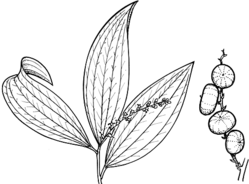Common name: Tree Heath, Axebreaker, Sandberry, Wheel-fruit, Waddy Wood
Trochocarpa laurina (Rudge) R.Br. APNI* Synonyms: Cyathodes laurina Rudge APNI*

Description: Compact shrub to crooked tree to 13 m high, glabrous; bark grey to brownish black, corky, finely fissured to platy.
Leaves alternate or in pseudowhorls at end of branches, new growth pink; elliptic to broad-elliptic, 5–7 cm long, 20–30 mm wide, apex acuminate, lamina with 5–7 ± longitudinal veins, upper surface glossy and dark green, lower surface paler, , petiole 3–6 mm long, sometimes sparsely hairy.
Flowers solitary or clustered in slender interrupted, chiefly terminal spikes, 20–40 mm long, white; bracteoles c. 0.4 mm long. Sepals c. 1 mm long. Corolla tube 2–3 mm long; lobes erect, lobes and throat bearded.
Fruit 6–8 mm diam., ribbed when dry, purple to black, ripening June-Sept.
Flowering: December–January
Distribution and occurrence: Grows in wet sclerophyll forest, warm-temperate rainforest to 800 m alt. and littoral rainforest, north from Bermagui.
NSW subdivisions: NC, CC, SC, NT, CT
Other Australian states: Qld
Text by B. Wiecek
Taxon concept: Flora of NSW 3 (1992)
ECOLOGY
Life History
Vegetative spread No.
Longevity Probably long, more than 10 years (A. Bofeldt pers. comm.).
Flowers White, December-January. Not automatically self-pollinated (Adam & Williams 2001).
Fruit/seed Succulent fruit (drupe), average fresh weight 180 mg, with multiple embryos per fruit (J. Howell pers. comm.)., 6--8 mm diam., purple to black, ripening June--September. 40,600 seeds per kg (Floyd 1989).
Dispersal, establishment and growth Diaspore: vertebrate-adapted fleshy fruit (Westoby et al. 1990), bird-dispersed, water-dispersed, germination 6--14 months, low germination rate, very slow-growing especially when young (A. Bofeldt pers. comm.). Germination difficult, may take up to 2 years (Floyd 1989).
Fire response Resprouts from base after high intensity fire (at Narrabeen Lake 1/1994, P. Kubiak pers. comm.), resprouts from stem/branches after low intensity fires (A. Bofeldt pers. comm.).
Interaction with other organisms Host to parasitic plant Korthasella rubra (Downey 1998). Host tree for epiphytes e.g. ferns, orchids (A. Bofeldt pers. comm.). Used by Aboriginal people for waddies (Floyd 1989).
Habitat
Habitat Gullies, amongst rocks, creeks, escarpment slopes.
Altitude 0--650 m
Annual rainfall 1200--1600 mm
Typical local abundance Frequent--rare.
Vegetation Warm temperate, sub-tropical, riverine, and sometimes dry rainforest (A. Bofeldt pers. comm.), moist eucalypt forest e.g. with Eucalyptus saligna, E. pilularis, Ceratopetalum apetalum, Acmena smithii, Syncarpia glomulifera, Backhousia myrtifolia, creek banks.
Substrate Sandy loam to yellow sandy clays from sandstone, shales (Illawarra Coal Measures, Hawkesbury Sandstone, Narrabeen Series in Illawarra, A. Bofeldt pers. comm.), moderate nutrient soils, well-drained.
Exposure Sheltered. Mid-shade, young plants not able to tolerate full sun (A. Bofeldt pers. comm.).
APNI* Provides a link to the Australian Plant Name Index (hosted by the Australian National Botanic Gardens) for comprehensive bibliographic data
***The AVH map option provides a detailed interactive Australia wide distribution map drawn from collections held by all major Australian herbaria participating in the Australian Virtual Herbarium project.
|


